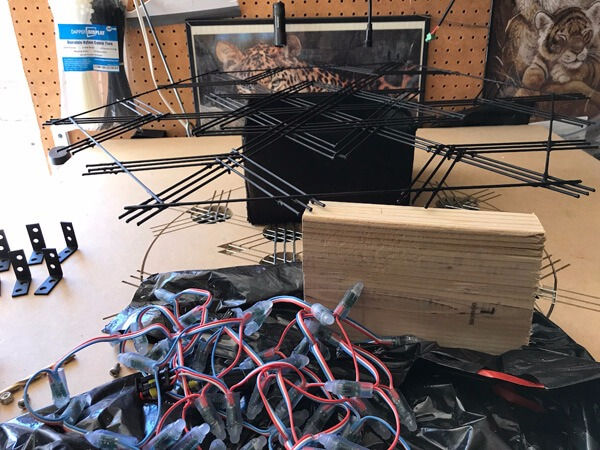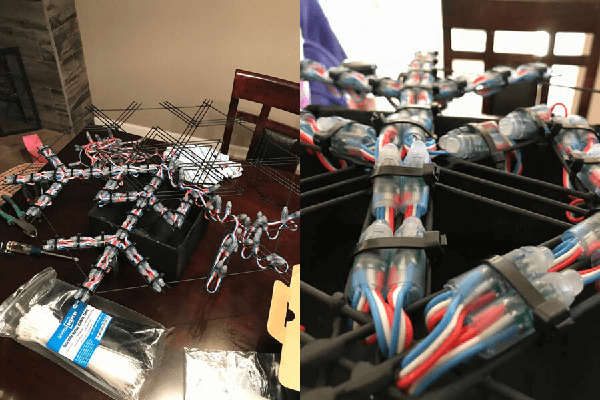
Supplies:
• 216 lights
• 3/4" MDF Board ~ $32 plus cutting fee
• Bolt Cutter
• JB Weld epoxy ~ $12 (I don't own a welder)
• Clamps made from screws and spare wood
• Flat Black Rust-Oleum Spray Paint ~ $5
• Zip Ties (UV Resistant) ~$10
• 30 hours to complete
My Design is based on Matt Johnson's How To Build A Pixel Snowflake Video.

Sketched Snowflake design on 3/4" MDF board. Snowflake end to end is 32" with 1/2" space between lines. (*End product uses straight lines, instead of curved pictured here, for ease in later gluing.) The purpose of the MDF board is to create a JIG that can be used to make several identical snowflakes. One board is enough for several designs. (wreaths, snowflakes, candy canes, etc.)

Drilled out door knob sized holes for the major joints.

Borrowed a friend's router to grind out the lines for the 12 gauge hanger wire.

Used a bolt cutter for the wires ...and since I don't own a welder, I went with JB Weld epoxy. It is super strong and works like a charm. Make sure to completely surround the wire connections (forming a sort of X-shaped epoxy "tube" around them).

I pinched the main joints with some scrap wood and screws to glue them together with pressure. It took 2 separate nights.
In my design, I'm keeping the middle wires for support (Matt cut them out in his design). Here you can also see where I changed from a circular outer ring to a hexagonal shape. (Makes gluing easier)

I popped the wooden clamps off and sanded away the splinters. Then sprayed flat black Rust-Oleum spray paint over it to protect from rust and hide the snowflake support frame when the lights are on. (You can see the smaller snowflake under this one ready to be glued.)

Working on zip-tying the lights: It takes quite some time and took several nights of work.

Here is the finished 32" snowflake with 216 lights attached.

Plugged it in and tested it out. The final 24 lights didn't light up...
It turns out I had the incorrect number on the e682 webpage. Once I updated the number to 216 they all light up.
ALSO, I had to POWER INJECT from the end of the light strand. More on Power Injection can be found here.
Click to see Snowflake Video Test


Back with the better photos!
Here is my LARGE Snowflake Jig. (I did not use the outer circle. I used straight wire to form a hexagon)
From the middle of the snowflake to the end, it's 16 inches. 32" diameter snowflake total.
Here is my SMALL Snowflake Jig.
Small snowflake middle to end is 12 inches. 24" total diameter snowflake.
This is how I cut and arranged the branch wires for more JB weld contact points and overall sturdier design.
Here is how I arranged the lights on my large snowflake: Since the middle of the snowflake fit 4 pixels, it ended up being too far of a stretch from pixel 26 shown to pixel 29. I then would have to extend the wires and solder on each snowflake arm... INSTEAD, I looped the design around so now pixel 28 was close enough to pixel 29 that I didn't need to do anything but continuously zip tie them on.
I continued this pixel pattern all the way around. Each time I came to the end of a strand of 50 pixels, I cut and soldered on the start of the next 50 for better waterproofing.
Here it is flipped over to the back side.
I extended the start pixel upward and added a waterproof connector. The last pixel in the large snowflake is pixel 216. Here, I extended it up and out about 6 feet. (which goes over and plugs into the next small snowflake.) You can also see I added to the end extension the power injection wires and its own waterproof connector. That way power comes from both the first pixel and the last pixel in the snowflake. Since I use 12 volt lights, I haven't had any voltage drop issues.
There really is no wrong way of wiring the lights... It all comes down to your sequencing software. This is how I set up the pixel order in excel for later copying into xLights. I color coordinated the numbers to help me remember which lights go inside certain submodels. Hope this helps!